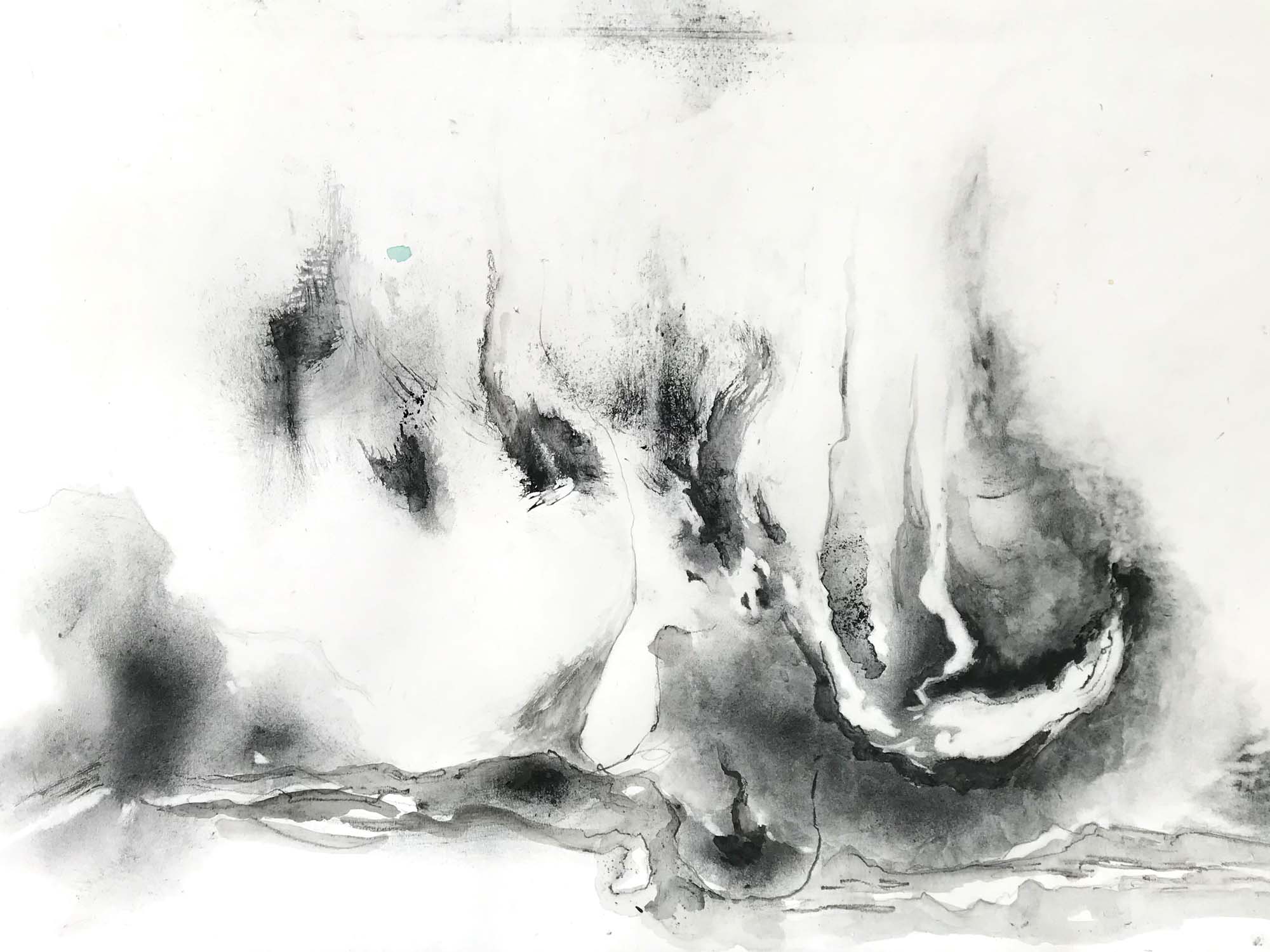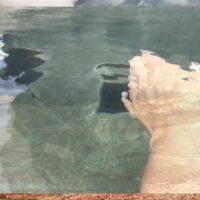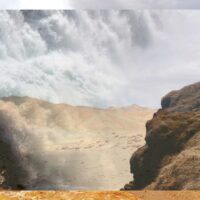Form emerges as an image reflected in water at rest in a stone basin. The phenomenon alludes to the essence of Sophia—a creature that finds infinity in finitude.
Water in a liquid state captures its power as mediator and form-changer. It moves between clouds and ice, between the airy and the solid. Water is solid when frozen, but is defined by the solid when held and contained. Walking in the mountains or along a stream, we see puddles in limestone dells or on the roads after a rain. The solid holds the water still, and we find the exquisite event of mirroring, unparalleled anywhere else in nature. A tiny touch or a gust of wind sends the pristine forms into braiding runs and ribbons. When stillness and the picture return, the corporeal is flattened. It is again a surface of light.
The reflection points toward a reality, but is at the same time distant from it. The real is not totally present in its reflection. The image is lifted slightly out of the world. It suspends the real while welcoming it from behind. It is like the children’s game where you sneak up and tap someone’s shoulder while crouching behind them on the other side. Here, where water is active yet formed by the solid state and its stillness, a small step toward inner life appears.
We experience this partial reality physically—you cannot enter a mirror image with your body, but you can move through it with your eyes and imagination. If we dwell on an image and how our movement through space is suspended in it, our passions, fears, desires, and habits of use can come into a paralysis: we are softly shocked. Displaced and de-timed, we sense the nearness of a mystery. We can feel a dual movement of vulnerability and freedom.
A related transformation of the world occurs before every act of judgment. Existence is suspended. The moment of suspension is an act of indeterminacy that can last shorter or longer. Out of its openness, all directions are potentials for action. Like the reflection in still water held by stone, it is formed through the shape of the creature we are. This form, however, can be approached from different sides. I can identify with the drama of isolation and independence inherent in my position in any moment. I can also take a step back and apprehend myself and the world as form. Both relate to the solid state. The first is like water that has become ice, the second, like water that is held by stone, allowing the emergence of an image.
When a moment becomes an image, it lacks a certain actuality. It is, in a way, less than what is reflected. This deficit is a prerequisite for the profound dimensions of life and human potential. Friedrich Schiller called this most basic aspect of perception “the emergence of contemplation” (Betrachtung). “In one’s senses there results a momentary peace; time itself, the eternally moving, stands still; and, as the divergent rays of consciousness converge, there is reflected against a background of transience an image of the infinite, namely form.” (Letter 25) This moment leads out to the infinite doors of creativity and art. Judgment and insight emerge and, most importantly, through the momentary suspension of our self-fullness against the world, the ethical ideal lights up.
The importance of this suspension between extended and creative life is easily underestimated. It is a pregnant moment. It is the most elementary presence of aesthetic experience. Aesthetic experience is often associated with art and culture while excluding science. One part of the “two-culture” debate of the English-speaking culture, or what is experienced as the tension between the sciences and the humanities, emerges here. Schiller, one of the great theorists of the general significance of the aesthetic condition, plays a part in this divide. Schiller denied science and reason any ability to affect human sensibilities (desires, feelings, and imagination). His Letters on the Aesthetic Education of Mankind set out an aesthetic culture that one-sidedly tended towards the arts and humanities.
The remarkable polymath Pavel Florensky eloquently articulates what is at stake in regard to natural science. For him, there can be no jump between a scientific observation and the movement in thinking to grasp it as a symbol:
Here, however, it must be said once and for all, and with the greatest emphasis, that the metaphysical significance in this symbolization, like that in any other authentic symbolism, is not built upon the sensuous images, but is contained in them, and they are determined by it; the images are not simply sensible as physical, but pronouncedly metaphysical; physical images carry the metaphysical ones within them and are illuminated by them.
Florensky finds the reconciliation between the creature and the creator in science, not just art. He does this in the spirit of Goethe, who also sought the emergence of the symbolic character at the end of a structured variety of experiments. It is this path to the symbol that differentiates it from spontaneous poetic creation or ethical action.
While discussing the various conditions that play a part in the emergence of color, Florensky comes to speak of the resistance that is needed to make colors possible. In pure light, color cannot appear. There is fullness in God—no one-sidedness. Only through constraint can color appear. Here, Florensky is deepening the meaning of turbidity as resistance in the emergence of color. He continues: this most delicate and sensitive resistance can be apprehended as a creature but not a terrestrial creature. It is not what we would usually imagine as a creature imbued with the inertia of a material body, impenetrable to the light. Nor is this creature the light of the divine or the divine itself. Florensky describes this creature as living between the activity of divine life and the passivity of creation. This creature, this element, he calls Sophia: “Only from the relationship of the two principles does it become clear that the Sophia is not the light, but its passive complement, and that the light is not the Sophia, but illuminates her.”
In the dynamic between water and form and the ever-reoccurring moment of aesthetic suspension, we meet this element again. Water comes to rest through the solidity of the world. Form emerges as an image. A solid register is suspended while finitude remains. It bears within itself the potential for wisdom—it is a finitude that can receive the spirit without being negated.
Notes
Florenskij, Pavel Aleksandrovič. Konkrete Metaphysik: ausgewählte Texte [Concrete Metaphysics: Selected Texts]. Pforte, 2006.
Schiller, Friedrich. On the Aesthetic Education of Man, in a Series of Letters. Clarendon Press, 1968.
Image Gilda Bartel





